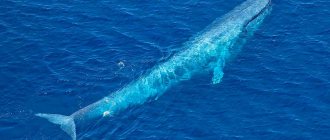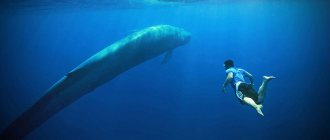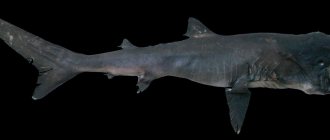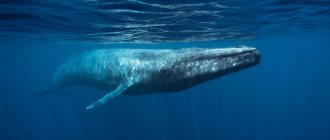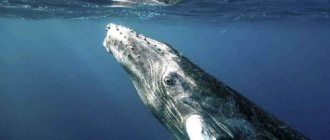The blue whale is considered the most giant mammal on planet Earth. It is also called blue whale. A whale can have a mass of one hundred and seventy tons and a maximum length of thirty-three meters. The blue whale belongs to a genus called minke whales. The blue whale was first described by Robert Sibbald (1864), so for many years the whale was called "Sibbald's minke."
Today's name for the blue whale was given by Carl Linnaeus. It comes from the phrase Balaenoptera musculus (Latin), the literal translation is “whale-winged mouse”.
Description
Scientists have not studied the blue whale for a long time. Systematic study of this natural giant began in the last decade of the twentieth century. Experts divided it into four types and assigned them the following names:
- northern blue whale;
- southern blue whale;
- dwarf blue whale;
- Indian blue whale.
All types have some differences, but they are minor. The northern and southern blue whale species enjoy cold circumpolar waters. Dwarf and Indian blue whales inhabit the tropical zone. There are no particular differences in the lifestyle of representatives of all species.
The blue whale's body is quite long and elongated. The head is also huge. It is approximately equal to one third of the length of the body. The head shape is U-shaped.
There are many folds of skin in the form of stripes on the whale's belly. They help stretch the pharynx as the whale swallows water. They also play an important role in hydrodynamic manipulation of the body during movement.
If we compare it with all species of baleen whales on the planet, the fin located on the upper part of the whale’s back will be smaller than that of other individuals. Its length is approximately 35 centimeters and it is located closer to the tail.
Whales have an incredible mass: from 150 to 180 tons. The weight of the largest blue whale was 190,000 kg, and its body length was 33 meters. It was a female. And the largest male blue whale had a body length of thirty-one meters and a weight of 180,000 kg.
The blue whales that live in the waters of the oceans today have become smaller: with a length of more than thirty meters they can be found very rarely and their mass is also gradually decreasing.
Sei whale (length 21.3 m)
A large baleen whale with a pointed muzzle grows on average up to 17 meters and reaches 30 tons of weight. The mobile whale is often called a torpedo; the animal is capable of moving at speeds of up to 25 kilometers per hour, and lives throughout the world's oceans with the exception of near-equator waters. The smooth back is often covered with spots - the consequences of wounds and parasitic lesions.
Females are larger than males, give birth every year, and mate in winter. Whales live in small groups of up to 5 individuals; the calves are breastfed for up to 7 months. This species is distinguished from other baleen whales by a powerful dorsal fin located in the tail part of the body and small pectoral flippers. Mammals are long-livers, living on average up to 75 years.
Appearance: characteristics and features
The blue whale is a giant mammal. Individuals living in the northern seas and oceans are usually 2-3 meters smaller than those that swim in the oceans of the tropical zone.
Representatives of the blue whale subspecies have the following parameters:
- Males - body length 23-25 m.
- Females - approximately 24-27 m.
- Weight 115-150 tons.
South whale skeleton
The huge body is streamlined and elongated in length. At the bottom of the pointed head there is a wide jaw. The very small eyes and respiratory organ located on the head are poorly developed. The whale has poor eyesight and a weak sense of smell. Exhalation is accompanied by the release of a ten-meter-high water fountain. In front of the respiratory organ there is a ridge located along the top of the head, it is called a breakwater.
Whales have good hearing and sense of touch. They compensate for poor sense of smell and insufficient vision.
The fin located on the back is shifted back and has the shape of a triangle. Its dimensions are small and it is covered with small gouges or scratches. The pattern on the fin created by nature is unique for each individual. The fins on the chest are narrow and elongated. Their length is approximately four meters. The caudal fin is wide. Its width is almost eight meters. The thick stalk of the tail has a small notch. It helps control the body when moving in water.
A distinctive feature of the blue whale is its numerous stripes, starting at the bottom of the head and continuing along the throat and belly. The number of these stripes, which are folds of the skin, ranges from 60 to 80.
In the upper part of the body the skin is smooth. It is painted gray, but has a blue tint. Nature painted the lower area of the head dark, and the back has a light shade. Gray spots of uncertain shape are distributed over the entire surface of the skin. Whale skin resembles marble stone.
If a whale dives shallowly under water, its body turns completely blue. Obviously, that’s why the animal was called the “blue whale.”
In the mouth of the giant whale there are meter-long plates of whalebone. They are made from keratin. In order not to let large animals pass through the mouth, a whale needs a baleen for this. It plays the role of a filter.
The plates are about fifty centimeters wide. The mass of one plate is almost ninety kilograms. Eight hundred plates are fixed in the upper part of the jaw. They are triangular in shape. A stiff, hair-like fringe protrudes from the top of each plate.
Characteristics:
- The presence of a huge lung capacity (3500 liters).
- 8,000 liters of blood circulate in the circulatory system.
- The weight of the tongue is about 4 tons.
- Huge heart (weight 800-1000 kg).
- The liver weighs 1000 kg
Fin whale (length 27 m)
The largest minke whale lives in the subpolar latitudes of both hemispheres in small groups of up to 6 individuals. The second name for the whale is herring. The height of the fountain reaches 6 meters. Maximum speed is 50 kilometers per hour. Females give birth to young annually. They often become prey for sharks. The maximum diving depth is 230 meters.
The shape of whales does not change with age; babies are born a copy of their parents. In proportions, the whale resembles a large fish with an elongated snout. The high dorsal fin adds similarity. Two respiratory channels are clearly visible on the head, the skin is unevenly covered with spots. The fin whale's mouth is pink or white with 360 plates. When diving, the whale bends its tail strongly and can not breathe for up to half an hour.
Where does it live?
In summer, blue whales prefer to live in the Arctic and Antarctic zones. In winter, they move to areas of warm ocean waters. For example, dwarf whales live permanently in the warm waters of the Indian Ocean.
In the area of the Antarctic and Arctic seas, the food supply is sufficient for living all year round. Why do whales begin to migrate to the southern regions in winter? Experts explain: baby whales freeze when they are in icy water for a long time due to a thin layer of subcutaneous fat. There are much more blue whales living in tropical areas than in northern regions. Experts have identified only nine populations of the species in northern waters.
Minke whale (length 10.7 m)
The whales, with their white bellies, fins, and stripes on their heads, live in small groups; only during the seasonal migration of krill do these whales gather in large populations of up to 100 individuals. They spend the summer in temperate latitudes and move to the tropics for the winter. Found all over the globe.
Tourists love to watch minke whales while hunting: large gray-white animals are very mobile, pirouette like dolphins, jump completely out of the water, and then fall noisily onto the water, raising fountains of spray. Every year, whaling ships catch up to 1,000 individuals in the North, and Japan accounts for up to 90% of the catch. The remaining carcasses go to Norway and Iceland.
Diet
The blue whale feeds on the following marine life:
- Pisces;
- Squid;
- Plankton.
Of course the diet is not very varied. The whale's main food is plankton. The fish are caught by the whale by accident when it swallows crustaceans. If there is little plankton on the way, then the whale swims up to a school of fish and swallows them. Exactly the same story with squid.
A whale, having encountered accumulated plankton, swims at high speed and at once captures a huge volume of water with its mouth. The animal expends enormous energy to obtain food, so it needs to look for places with a large accumulation of food. A whale's stomach holds about two tons of food.
In order for a whale to be satisfied, it must swallow 1500 kg of food in one go. The daily food requirement is four tons of food. To get food, the whale dives into the water column to a depth of 90-150 meters.
Pygmy killer whale
Scientific name: Feresa attenuata Length: about 2 m. Weight: about 170 kg.
The pygmy killer whale is not very close in genus to killer whales. She was named that way solely because of her external resemblance. They have a very harsh disposition in captivity. Although in the wild they did not show aggression towards humans.
12
Lifestyle
Blue whales lead an isolated lifestyle. They often swim alone. But it happens that they gather in small herds. The animal's main activity is carried out during the day. To communicate with their fellow whales, whales use infrasound signals. They can spread them over fairly long distances (maximum 33 kilometers).
In places where there is an abundance of food, whales gather in schools. The herd can number up to 60 animals. Being in a school with its fellows, the whale always stays apart.
A blue whale can dive into the water for about five hundred meters and stay there for a maximum of fifty minutes. When obtaining food, it dives into the water column to 200 meters with a frequency of 6-19 minutes. Having emerged, it always emits a water fountain.
When moving, a blue whale can reach a top speed of about 48 km/h. While feeding, the animal does not move very quickly (2-6 km/h).
killer whale
Scientific name: Orcinus orca Length: 6 – 8 m. Weight: about 6 tons
Killer whales are one of the best predators in the world's oceans. They easily hunt tiger and white sharks, and even larger whales, including sperm whales and gray whales. A complex social hierarchy and high intelligence help them become brilliant hunters.
There are no cases of killer whales attacking humans in open water. However, in captivity (aquariums), these creatures drowned trainers, but did not eat them. Hence the conclusion: killer whales do not consider people as food.
11
Reproduction
The long period for reproduction does not allow whales to reproduce quickly. Its growth rate is very slow. The blue whale is monogamous. The male finds his female and then he will stay near her all his life and protect her. A female can become pregnant only once in two years. She carries the cub for a whole year.
Newborn baby whale:
- Weighs two to three tons. Has a body length of 6-9 meters;
- His mother breastfeeds him for seven months;
- He eats 90 liters of mother's milk per day. The fat content of milk is 40-50% and it contains a lot of protein.
When the cub is one and a half years old, it grows to 20 meters and weighs almost 50 tons.
The blue whale matures sexually when it is ten years old. The body reaches full physical fitness by the age of 15. By this time, the whale has fully grown and gained adult weight.
Hector's dolphin
Scientific name: Cephalorhynchus hectori Length: up to 1.4 m. Weight: 40 – 60 kg.
Hector's dolphin is one of the smallest and rarest species of cetacean dolphin on Earth. Until now, nothing is known about their social hierarchy, level of intelligence development and methods of communication.
This species was first described in 1881 by a scientist from Belgium. Hector's dolphin is endemic to New Zealand, and received its name from the Wellington Museum employee who discovered this species.
9
Population today
Intensive hunting has led to a severe decline in the number of blue whales. Researchers estimate that there are only about 2,000 individuals left on Earth. There are 600 individuals living in the sea waters of the north. The blue whale or vomit whale is considered an endangered species. Today, catching blue whales is strictly prohibited.
Slow population reproduction is complemented by the following factors:
- The water in the oceans and seas is becoming polluted;
- Whales collide with ships;
- Casting a large number of long nets.
In recent years there has been a slight increase in the population. This gives us hope that the species will be preserved. In addition to the above reasons, there is one more: the reproduction of small southern whales. They outpace the huge, clumsy whales and eat large accumulations of plankton before the giants get to them.
Useful cleaners
Some whale inhabitants benefit their owners. The copepods Balenophilus, which live in the whale's mouth, coordinately perform the work of a toothbrush. The external cleaners of whales are fish - 85 cm long fish. With the help of a large suction cup on the head, these fish attach to the whale and eat parasites from the surface of its body.
Natural enemies
The main natural enemy of the blue whale is the killer whale. Killer whales prefer to hunt sick or young whales. They gather in a large flock and force the whale to dive into the water. Then they prevent it from rising above the surface of the water to take in air. When the whale weakens, the killer whales tear off pieces from its body. The whale completely loses all his strength and the killer whales kill him.
The killer whale is the enemy of the blue whale
But the main enemies of the blue whale are people. Whaling has contributed to a sharp decline in the number of blue whales. People began to exterminate whales in the second half of the 19th century. As a result, the humpback whale was practically exterminated and then they took up the blue whale.
Parasites
Among the fouling organisms of whales that feed on the blood and tissues of the host, there are several species of crustaceans. The whale is especially worried about the numerous copepods PENELLA, also called whale lice. These parasites, the largest of the copepods at 32 cm, plunge into the skin of whales to a depth of 5 - 7 cm and leave non-healing ulcers. Odontobius roundworms live on the baleen of blue whales. The bodies of whales are often covered with 40 cm maxines and 80 cm leechmouths bite into the body of the whale with horny teeth and tear off pieces of meat from the animal. To make it stick tighter, the maxine is even tied into a knot. Gluttonous leeches are capable of swallowing meat 8 times their own weight in 7 hours
Blue whale conservation
The inclusion of the blue whale in the Red Book brought results - its production stopped. Whale fishing was banned back in 1966. For forty years now, no cases of blue whale poaching have been identified. The gigantic size of the whale's body did him good. Poachers need a very large vessel, which makes organizing a hunt much more difficult.
The restoration of the population of individuals is negatively affected by the pollution of the oceans and the release of floating nets. Many states have set strict standards regarding the size and number of networks. Laws in several countries around the world require that ship speeds be reduced in areas where blue whales live.
Lesser/False Killer Whale
Scientific name: Pseudorca crassidens Length: about 6 m Weight: about 2.2 tons
The false killer whale got its name due to the structure of the skull, which is very similar to that of the killer whale. These are social creatures - they live in large flocks, constantly migrate and are not at all afraid to come close to people. It can be difficult to “predict” their movements. There have been cases when false killer whales in large flocks entered coastal waters, chasing prey, or even washed ashore.
In captivity, they are docile creatures that are often kept in aquariums.
13
bottlenose dolphin
Scientific name: Tursiops Length: about 4 m. Weight: about 300 kg
Bottlenose dolphins are the common name for the three extant species of toothed whales of the genus Bottlenose dolphins, namely the common bottlenose dolphin, the Australian bottlenose dolphin, and the Indian bottlenose dolphin. These animals are known for their cognitive abilities such as mimicry and learning. Because of this feature and their friendly nature, including towards people, they are frequent participants in aquarium shows.
When communicating, bottlenose dolphins send each other signals with a frequency of 20 to 170 kHz. The complexity of the signals is determined by the species and age of the individuals.
17
California porpoise
Scientific name: Phocoena sinus Length: about 1.2 – 1.5 m. Weight: about 43 kg.
The Vaquita porpoise is considered the smallest in size among all cetaceans. Their peculiarity is dark “bags” under the eyes. These mammals avoid contact with humans, although they are not aggressive.
Vaquitas are an endangered species of cetacean. In 2005, the Mexican authorities took them under special protection and declared the Gulf of California an ecological refuge for these amazing creatures.
By the way, “Vakita” is translated from Spanish as “little cow.”
18
